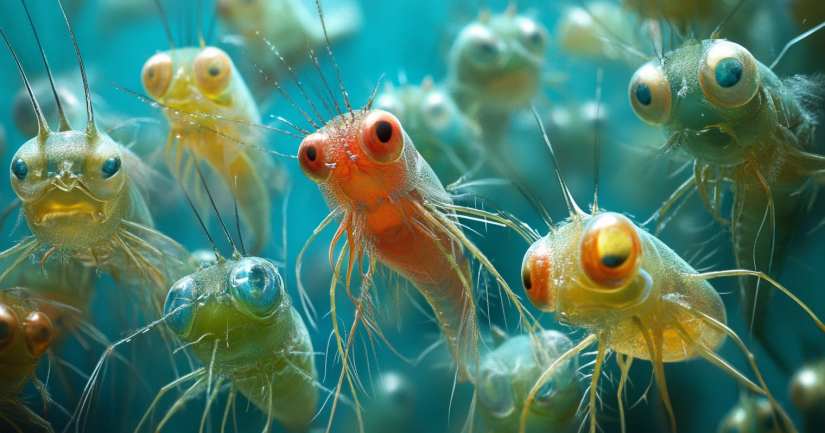
Plankton Quiz, Test Your Knowledge of the Ocean’s Tiny Powerhouses! They may be microscopic, but plankton are some of the most important organisms on Earth! These tiny drifters fuel the ocean’s food chain, produce most of the oxygen we breathe, and even play a role in regulating the planet’s climate. Whether they’re phytoplankton (plant-like) or zooplankton (animal-like), these floating organisms are the foundation of marine life. But how much do you really know about these oceanic powerhouses? Take our Plankton Quiz and find out!
Plankton are not a single species but a diverse collection of drifting organisms found in oceans, lakes, and even ponds. Some, like phytoplankton, are microscopic algae that photosynthesize, while others, like krill and jellyfish larvae, are zooplankton, tiny creatures that feed on phytoplankton and other planktonic organisms.
Plankton may be small, but they’re essential! Explore the hidden world of oysters in our Oyster Trivia or discover the playful, charismatic sea otters in our Sea Otter Trivia.
Mind-Blowing Plankton Facts That Might Surprise You
- Plankton Produce Over Half of Earth’s Oxygen – Phytoplankton absorb carbon dioxide and release oxygen, making them essential for maintaining Earth’s atmosphere.
- They Are the Base of the Marine Food Chain – Nearly all ocean life, from tiny fish to massive whales, depends on plankton as a primary food source.
- Some Plankton Glow in the Dark – Certain species of phytoplankton, like dinoflagellates, produce bioluminescence, creating glowing waves and shimmering seas at night.
- Plankton Come in All Sizes – Some, like cyanobacteria, are microscopic, while others, like giant jellyfish larvae, can be several inches long!
- Krill Are One of the Most Abundant Zooplankton – These shrimp-like creatures form massive swarms and are a primary food source for whales, seals, penguins, and seabirds.
- Plankton Help Regulate Earth’s Climate – By absorbing carbon dioxide, plankton play a role in reducing greenhouse gases and controlling global temperatures.
- There Are Plankton in Freshwater Too – While most people associate plankton with the ocean, they are also found in lakes, rivers, and ponds, supporting freshwater ecosystems.
- Some Plankton Are Temporary – Certain marine animals, like crabs and sea stars, spend their larval stages as plankton before settling on the ocean floor.
- Plankton Blooms Can Be Seen from Space – Massive plankton blooms, especially phytoplankton explosions, are visible from satellite images, often creating colorful ocean swirls.
Harmful Algal Blooms (HABs) Can Be Dangerous – While most plankton are harmless, some phytoplankton species, like red tide algae, produce toxins that can be deadly to marine life and even harmful to humans.
The Role of Plankton in Marine Ecosystems
Without plankton, life in the ocean—and on Earth—would not exist as we know it. These microscopic organisms support entire food webs, regulate carbon levels, and contribute to the oxygen cycle. However, climate change, ocean acidification, and pollution are affecting plankton populations, which could have serious consequences for marine biodiversity and global ecosystems.
Are You Ready to Take the Ultimate Plankton Quiz?
If you love marine biology, ocean conservation, or learning about Earth’s tiniest but mightiest organisms, this Plankton Quiz is for you! Whether you’re fascinated by bioluminescence, their role in climate change, or their importance to marine life, this quiz will challenge your knowledge and reveal amazing facts about these unseen ocean giants.
So, are you ready to test your knowledge and explore the hidden world of plankton? Take the Plankton Quiz now and see if you’re a true marine science expert! 🌊🔬
Love the ocean? Test your knowledge with the Guess the Sea Animal Quiz, discover your marine match in the What Sea Animal Am I Quiz, or explore more Marine Quizzes for underwater fun!
Plankton – FAQ
Plankton refers to a diverse group of microscopic organisms that drift in ocean currents. They play a crucial role in marine ecosystems as primary producers, especially phytoplankton, which photosynthesize and produce oxygen. These tiny organisms are the foundation of the aquatic food web, supporting various marine life, from small fish to large whales.
Plankton is broadly categorized into two main types: phytoplankton and zooplankton. Phytoplankton are plant-like organisms that harness sunlight for energy, while zooplankton are small animal-like organisms that feed on phytoplankton and other small creatures. Additionally, there are bacterioplankton, which are essential for nutrient cycling in the ocean.
Plankton, particularly phytoplankton, significantly influences the global carbon cycle. Through photosynthesis, they absorb carbon dioxide from the atmosphere and convert it into organic matter. When they die, some of this carbon sinks to the ocean floor, sequestering it and helping to regulate the Earth’s climate.
Plankton populations are influenced by various factors, including nutrient availability, light conditions, water temperature, and salinity. Seasonal changes can also impact their abundance and diversity, as different species thrive under varying environmental conditions.
Human activities, such as pollution, overfishing, and climate change, can significantly affect plankton communities. Nutrient runoff from agriculture can lead to harmful algal blooms, while rising ocean temperatures may disrupt the delicate balance of plankton ecosystems. Protecting these vital organisms is essential for maintaining healthy marine environments.
